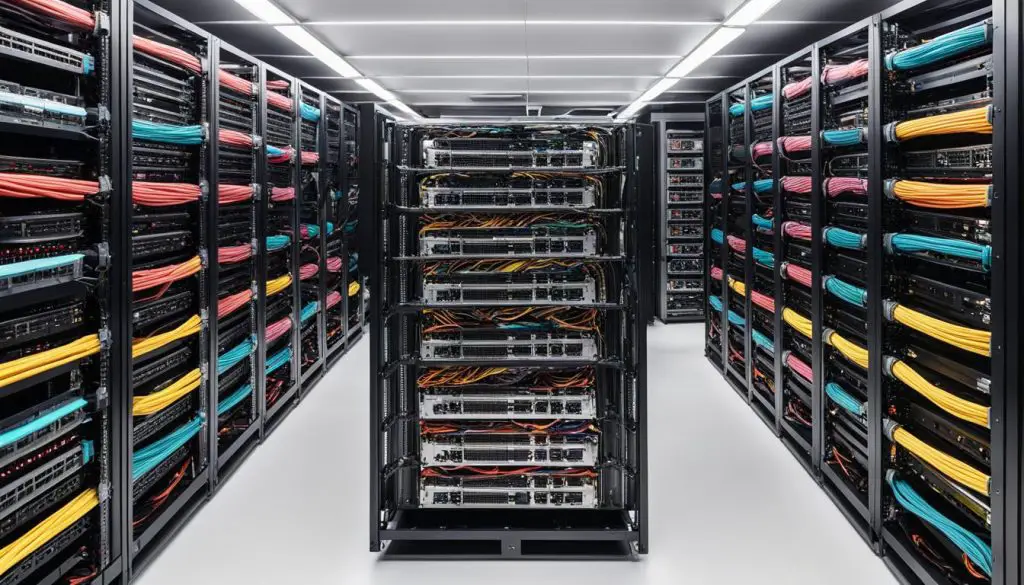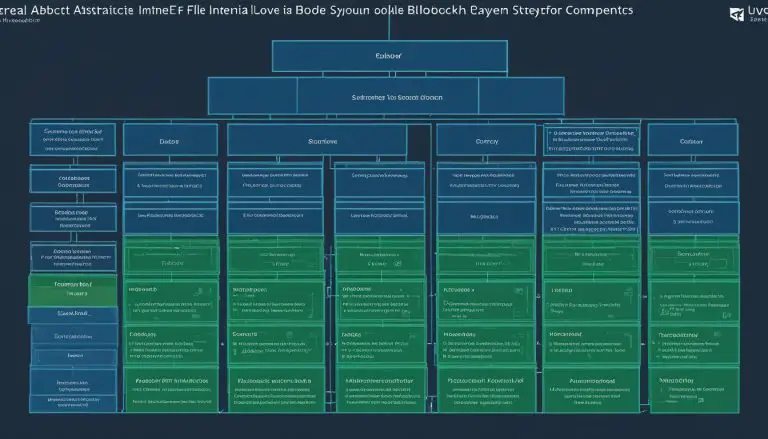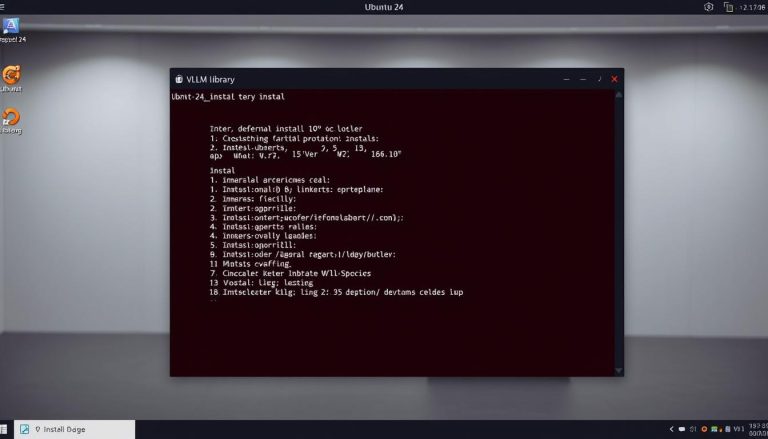How to Create a ZFS Pool: A Step-by-Step Guide
Growing storage needs require robust and efficient solutions, and ZFS pools offer precisely that. Creating a ZFS pool is a straightforward process that involves a few simple steps. In this guide, I will walk you through the process of creating a ZFS pool, from setting up the pool to configuring it according to your needs.
To create a ZFS pool, you will need to use the zpool create command. This command requires a pool name and one or more virtual devices as arguments. The pool name should comply with the naming requirements specified in ZFS Component Naming Requirements. The virtual devices can be entire disks or slices on preformatted disks.
For example, to create a basic storage pool named “tank” using the disks c1t0d0 and c1t1d0, you can use the following command:
Key Takeaways:
- Creating a ZFS pool involves using the zpool create command.
- The pool name should comply with the naming requirements.
- Virtual devices can be entire disks or slices on preformatted disks.
- Consider the hardware and software requirements for optimal ZFS performance.
- Configuring a ZFS pool can provide data redundancy and improve performance.
Determining Storage Requirements and Available Devices
Before creating a ZFS storage pool, it is essential to determine your storage requirements and identify the available devices that can be used. This step is crucial for ensuring optimal performance and efficient data management. Here’s what you need to consider:
Determining Storage Requirements
To determine your storage requirements, assess the amount of data you need to store and anticipate future growth. Consider factors such as:
- The size of your existing data
- The expected growth rate of your data
- The specific use cases and workloads for the storage pool
By analyzing these factors, you can estimate the total capacity needed and plan accordingly.
Available Devices for ZFS
Once you have determined your storage requirements, the next step is to identify the available devices that can be used in your ZFS pool. It is important to choose devices that meet the hardware requirements for ZFS and support the desired level of performance and redundancy.
Here are some key considerations when selecting storage devices:
- Disks: Choose disks with a minimum size of 128 MB. These disks should be dedicated for use in the ZFS pool and not in use by other parts of the operating system.
- Slice or Entire Disk: You can utilize entire disks or slices on preformatted disks as storage devices for your ZFS pool. Slices allow for more granular control and flexibility in allocating storage space.
It is also recommended to have multiple controllers when creating a mirrored configuration. This helps improve performance and provides better fault tolerance in case of device failure.
ZFS Hardware Requirements
Ensure that your hardware meets the requirements for running ZFS efficiently. Some factors to consider include:
- Operating System: ZFS requires Solaris Nevada release build 27 or later to function properly. Make sure your system meets this requirement.
- Memory: It is recommended to have at least 1 GB of memory for optimal ZFS performance. However, a minimum of 512 MB is acceptable for a basic system installation.
By carefully determining your storage requirements, selecting suitable devices, and ensuring hardware compatibility, you can create a robust and efficient ZFS storage pool that meets your specific needs.
| Storage Device | Minimum Size | Notes |
|---|---|---|
| Disks | 128 MB | Dedicated for ZFS use and not used by other parts of the operating system |
| Slices on Preformatted Disks | 128 MB | Allows for more granular control and flexibility in allocating storage space |
Creating a Non-Redundant Storage Pool
A non-redundant storage pool, although not recommended for production environments due to the lack of data redundancy, can be created easily in a ZFS configuration. By using the zpool create command followed by a pool name and one or more storage devices, you can establish a basic non-redundant ZFS pool.
It is important to note that non-redundant storage configurations do not provide the same level of protection against data loss as other ZFS pool configurations. Therefore, they are better suited for non-critical or temporary storage needs.
When creating a non-redundant storage pool, consider the following steps:
- Choose a suitable pool name that complies with ZFS naming requirements
- Select one or more storage devices to be included in the pool
- Execute the zpool create command with the chosen pool name and storage devices
Here is an example of creating a non-redundant ZFS pool:
In this example, the pool named “mypool” is created using the storage devices “/dev/sdb1” and “/dev/sdc1”.
By following these steps, you can create a non-redundant storage pool to meet your specific needs. However, it’s crucial to keep in mind that this configuration should not be used in critical production environments where data protection is a priority.
Creating a Mirrored Storage Pool
One of the key features of ZFS is its ability to provide data redundancy through mirrored storage pools. By utilizing multiple mirrors of storage devices, you can ensure that your data remains intact even in the event of a disk failure.
To create a mirrored storage pool, you will need to use the mirror keyword followed by the storage devices that will comprise each mirror. You can specify multiple mirrors by repeating the mirror keyword. This configuration offers increased fault tolerance and allows for better performance by distributing read and write operations across multiple disk sets.
Here is an example of how to create a mirrored storage pool:
sudo zpool create mirror_pool mirror /dev/sda /dev/sdb mirror /dev/sdc /dev/sdd
In this example, I have created a storage pool named “mirror_pool” with two mirrors. The mirror keyword is used to designate which storage devices will be part of each mirror. In this case, I have specified that /dev/sda and /dev/sdb form one mirror, while /dev/sdc and /dev/sdd form another mirror.
In a mirrored storage pool, the data is duplicated across the mirrors, providing redundancy. If one mirror fails, the data can still be accessed from the remaining mirrors, ensuring data integrity and availability.
It’s important to note that when creating a mirrored storage pool, it’s recommended to have an even number of devices in each mirror for optimal performance. This ensures that read and write operations can be balanced evenly across the mirrors.
By creating a mirrored storage pool in ZFS, you can enhance the reliability and performance of your storage system. It offers peace of mind knowing that your data is protected and accessible even in the face of hardware failures.
Benefits of a Mirrored Storage Pool:
- Redundancy: Mirrored storage pools provide data redundancy, minimizing the risk of data loss.
- Improved Performance: By distributing read and write operations across multiple disk sets, mirrored storage pools can offer better performance compared to non-redundant configurations.
- Flexibility: Mirrored storage pools can easily be expanded by adding more mirrors to the pool, allowing for scalability.
Considerations for Mirrored Storage Pools:
When creating a mirrored storage pool, it’s important to consider the following:
- Cost Considerations: Creating a mirrored storage pool requires a higher number of storage devices compared to non-redundant configurations, which may impact the overall cost.
- Hardware Requirements: Ensure that your hardware meets the minimum requirements for ZFS and supports the creation of mirrored storage pools.
- Monitoring: Regularly monitor the health and status of the storage devices in your mirrored pool to detect and address any potential issues.
| Advantages | Disadvantages |
|---|---|
| Enhanced data redundancy | Increased storage cost due to duplication of data |
| Improved fault tolerance | Requires a higher number of storage devices |
| Increased read and write performance | Requires additional monitoring and management |
Creating a ZFS Root Pool
When it comes to creating a ZFS root pool, it enables you to install and boot from a ZFS root file system. However, there are specific requirements and limitations that you need to be aware of. In order to set up a ZFS root pool, the disks used must have a VTOC (SMI) label, and the pool must be created with disk slices.
You have the flexibility to create the root pool as a mirrored configuration or a single-disk configuration. However, it’s important to note that you cannot create multiple mirrored top-level virtual devices for the root pool. Additionally, a RAID-Z or striped configuration is not supported for the root pool.
It’s crucial to ensure that your root pool configuration complies with these requirements to avoid any potential issues during the installation and booting processes.
ZFS Root Pool Limitations
Creating a ZFS root pool has its limitations, and it’s important to be aware of them. Here are some key limitations:
- A VTOC (SMI) labeled disk is required for the root pool.
- The pool must be created with disk slices.
- Multiple mirrored top-level virtual devices cannot be created.
- RAID-Z or striped configurations are not supported.
By understanding these limitations, you can ensure that your ZFS root pool configuration aligns with the recommended guidelines and best practices.
Creating a RAID-Z Storage Pool
RAID-Z is a powerful feature in ZFS that provides data redundancy, similar to RAID-5. By creating a RAID-Z storage pool, you can enhance the fault-tolerance and integrity of your ZFS pool. To create a RAID-Z storage pool, you need to use the raidz or raidz1 keyword in the zpool create command, followed by the storage devices that will comprise the RAID-Z device.
Here’s an example of creating a RAID-Z storage pool:
zpool create tank raidz /dev/sda /dev/sdb /dev/sdc /dev/sdd
In this example, tank is the name of the storage pool, and /dev/sda, /dev/sdb, /dev/sdc, and /dev/sdd are the storage devices that will form the RAID-Z device.
This configuration provides fault tolerance by distributing data and parity information across the storage devices. It offers enhanced data protection and performance, allowing for the recovery of data in case of device failures.
Advantages of RAID-Z
- Redundancy: RAID-Z ensures that your data remains available even if a storage device fails.
- Efficiency: RAID-Z maximizes storage capacity by using the minimum amount of parity data.
- Data Integrity: Built-in checksums protect against data corruption and maintain the integrity of your data.
- Performance: RAID-Z offers excellent read performance, and write performance improves with the addition of more vdevs.
| RAID-Z Level | Fault Tolerance |
|---|---|
| raidz1 | Single-drive redundancy (equivalent to RAID-5) |
| raidz2 | Double-drive redundancy |
| raidz3 | Triple-drive redundancy |
By choosing the appropriate RAID-Z level and storage devices, you can create a fault-tolerant and reliable ZFS storage pool. Remember to consider your data redundancy needs and performance requirements when configuring your RAID-Z storage pool.
Creating a ZFS Storage Pool with Log Devices
ZFS allows you to enhance the performance of your storage pool by creating log devices, also known as intent log devices. These log devices provide a dedicated space for synchronous writes, improving the overall efficiency of your ZFS pool.
You have the flexibility to configure log devices when creating the storage pool or add them later to an existing pool. To create a storage pool with log devices, use the log keyword followed by the storage devices that will serve as the log. For example:
This command creates a storage pool named “tank” using the disks c1t0d0 and c1t1d0 as a mirrored configuration and assigns c2t0d0 and c2t1d0 as log devices for synchronous writes.
Integrating log devices into your ZFS storage pool setup can significantly improve performance, especially in scenarios that involve frequent synchronous writes.

Benefits of Using Log Devices
By incorporating log devices into your ZFS storage pool configuration, you can experience several advantages:
- Improved performance for workloads involving frequent synchronous writes
- Enhanced responsiveness and reduced latency when dealing with critical transactions
- Increased data integrity and reduced risk of data loss
These log devices serve as a buffer for synchronous writes, allowing the storage pool to handle write requests more efficiently. As a result, you can achieve better performance and reliability for your ZFS storage solutions.
Creating a ZFS Storage Pool with Cache Devices
ZFS allows you to optimize the performance of your storage pool by utilizing cache devices. Cache devices are dedicated components that store frequently accessed data, improving read and write speeds. By configuring cache devices in your ZFS storage pool, you can experience enhanced performance and responsiveness.
To create a ZFS storage pool with cache devices, you can use the cache keyword followed by the storage devices that will serve as the cache. For example:
1 | zpool add tank cache c3t4d0 |
Benefits of Cache Devices
Cache devices play a crucial role in improving the performance of your ZFS storage pool. By caching frequently accessed data, these devices reduce the need to retrieve information from slower storage media, such as hard disk drives. This results in faster access times and improved overall performance.
Choosing Cache Devices
When selecting cache devices for your ZFS storage pool, it is important to choose reliable and high-performance components. Solid-state drives (SSDs) are often preferred as cache devices due to their fast read and write speeds. However, it is important to balance cost and performance considerations when choosing cache devices.
Configuring Cache Devices
The configuration of cache devices in a ZFS storage pool is straightforward. Simply specify the cache devices using the cache keyword followed by the appropriate device names in the zpool add command. ZFS will automatically recognize and utilize these devices to optimize performance.
Monitoring Cache Devices
It is important to monitor the performance and health of cache devices in your ZFS storage pool. You can use the zpool status command to check the status of your storage pool, including the cache devices. Additionally, ZFS provides command-line utilities and graphical interfaces that allow for more detailed monitoring and analysis of cache devices.
Summary
Adding cache devices to your ZFS storage pool is a recommended approach for improving performance. By strategically caching frequently accessed data, you can significantly enhance read and write speeds, resulting in a more responsive storage system. When selecting and configuring cache devices, it is essential to consider the specific requirements of your workload and choose reliable components for optimal performance.
| Benefits of ZFS Cache Devices |
|---|
| Improved read and write speeds |
| Enhanced overall performance |
| Faster access times |
ZFS Hardware and Software Requirements and Recommendations
Before setting up ZFS, it is important to ensure that your hardware and software meet the requirements for ZFS. Here are the minimum requirements and recommendations:
Hardware Requirements
– Your system should run the Solaris Nevada release, build 27 or later.
– Disks used for ZFS should have a minimum size of 128 MB.
– It is recommended to have multiple controllers for mirrored configurations to ensure better performance and fault tolerance.
Software Requirements
– The recommended minimum memory allocation for optimal ZFS performance is 1 GB. However, a minimum of 512 MB is acceptable for a basic system installation.
Make sure your hardware and software meet these requirements before proceeding with the creation of a ZFS storage pool.
| Requirement | Minimum | Recommended |
|---|---|---|
| Solaris Release | Nevada, build 27 or later | Nevada, build 27 or later |
| Memory Allocation | 512 MB | 1 GB |
| Disks Size | 128 MB | 128 MB |
| Mirrored Configurations | Multiple controllers | Multiple controllers |
Conclusion
In conclusion, creating a ZFS storage pool is a straightforward process that involves determining your storage requirements, selecting suitable devices, and using the zpool create command. Depending on your data redundancy and fault-tolerance needs, you can choose from non-redundant configurations, mirrored configurations, and RAID-Z configurations. Moreover, ZFS offers the flexibility to create storage pools with log devices and cache devices, further enhancing performance.
When creating and managing ZFS storage pools, it is crucial to consider hardware and software requirements. Ensure that your disk sizes meet the minimum requirement of 128 MB, allocate sufficient memory, and use an operating system version that supports ZFS. By following the appropriate steps and understanding the available options, you can create robust and efficient storage solutions with ZFS pools.
In summary, ZFS provides a powerful and versatile solution for managing storage pools. Its ability to offer data redundancy, fault tolerance, and performance optimization through log devices and cache devices makes it a reliable choice for various applications. With a clear understanding of your storage requirements and the available ZFS configurations, you can confidently create ZFS storage pools that meet your specific needs.
FAQ
How do I create a ZFS pool?
To create a ZFS pool, you can use the zpool create command followed by a pool name and one or more virtual devices. The pool name should comply with the naming requirements specified in ZFS Component Naming Requirements, and the virtual devices can be entire disks or slices on preformatted disks.
How do I determine my storage requirements and available devices for ZFS?
Before creating a ZFS storage pool, it is essential to determine your storage requirements and identify the available devices that can be used. You should consider factors such as the minimum disk size, memory allocation, and compatible operating system versions. It is recommended to have multiple controllers for mirrored configurations to ensure better performance and fault tolerance.
How do I create a non-redundant storage pool in ZFS?
Creating a non-redundant storage pool in ZFS is straightforward. You can use the zpool create command followed by a pool name and one or more storage devices to create a non-redundant ZFS pool.
How do I create a mirrored storage pool in ZFS?
To create a mirrored storage pool in ZFS, you can use the zpool create command with the mirror keyword followed by the storage devices that will comprise each mirror. You can specify multiple mirrors by repeating the mirror keyword.
How do I create a ZFS root pool?
It is possible to create a ZFS root pool, which allows you to install and boot from a ZFS root file system. However, there are specific requirements and limitations when creating a ZFS root pool, such as using disks with a VTOC (SMI) label and creating the pool with disk slices. The root pool can be created as a mirrored configuration or a single-disk configuration, but multiple mirrored top-level virtual devices cannot be created. RAID-Z or striped configurations are not supported for the root pool.
How do I create a RAID-Z storage pool in ZFS?
To create a RAID-Z storage pool in ZFS, you can use the zpool create command with the raidz or raidz1 keyword followed by the storage devices that will comprise the RAID-Z device.
How do I create a ZFS storage pool with log devices?
ZFS allows you to create a storage pool with log devices, also known as intent log devices, which can improve storage pool performance by providing a dedicated space for synchronous writes. You can set up log devices when creating the storage pool or after the pool is created by using the log keyword followed by the storage devices that will serve as the log.
How do I create a ZFS storage pool with cache devices?
ZFS allows you to create a storage pool with cache devices, which enhance performance by caching frequently accessed data. To create a storage pool with cache devices, use the cache keyword followed by the storage devices that will serve as the cache.
What are the hardware and software requirements for ZFS?
Before setting up ZFS, it is important to ensure that your hardware and software meet the requirements. Your system should run the Solaris Nevada release, build 27 or later, and have sufficient memory, preferably at least 1 GB, for optimal ZFS performance. Disks used for ZFS should have a minimum size of 128 MB.
What are the best practices for creating ZFS pools?
The best practices for creating ZFS pools include considering your storage requirements, selecting suitable devices, and following the recommended hardware and software requirements. It is also important to choose the appropriate configuration for your needs, such as non-redundant, mirrored, or RAID-Z configurations. Additionally, you can enhance performance by using log devices or cache devices in your ZFS storage pool.
Source Links
- About the Author
- Latest Posts
Mark is a senior content editor at Text-Center.com and has more than 20 years of experience with linux and windows operating systems. He also writes for Biteno.com






